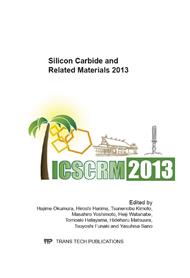p.871
p.875
p.879
p.883
p.887
p.891
p.895
p.899
p.903
The Role of Substrate Compensation on DC Characteristics of 4H-SiC MESFET with Buffer Layer: A Combined Two-Dimensional Simulations and Analytical Study
Abstract:
An analytical model of 4H-SiC metal semiconductor field effect transistor (MESFET) is proposed with buffer layer on high purity semi-insulating (HPSI) 4H-SiC substrate compensated by multiple deep level traps. The contribution of deep level traps (DLT) is projected and verified using two-dimensional simulations (Silvaco®). The modeled DC characteristics are compared with two-dimensional simulations performed on the same device as considered in the analytical model.The 4H-SiC MESFET is simulated with and without the effect of buffer layer and the electron concentration profiles in different regions are observed from two-dimensional simulations.The electron concentration profiles obtained at channel-substrate interface clearly shows that when the buffer layer is not present, the channel electrons get trapped by the deep level traps used for substrate compensation. It is also observed that the inclusion of buffer layer minimizes the extent of electron trapping by screening out the active channel from the substrate. However, the trapping phenomena take place in both the cases.We believe that the proposed model of 4H-SiC MESFET which includes the substrate compensation through multiple deep level traps may be useful for realizing SiC based monolithic circuits (MMICs) on HPSI substrates.
Info:
Periodical:
Pages:
887-890
Citation:
Online since:
February 2014
Authors:
Price:
Сopyright:
© 2014 Trans Tech Publications Ltd. All Rights Reserved
Share:
Citation:


